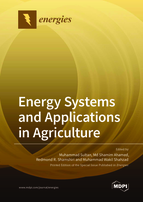Energy Systems and Applications in Agriculture
A special issue of Energies (ISSN 1996-1073). This special issue belongs to the section "B: Energy and Environment".
Deadline for manuscript submissions: closed (30 June 2022) | Viewed by 33215
Special Issue Editors
Interests: developing energy efficient heat- and/or water-driven temperature and humidity control systems for agricultural storage; greenhouse; livestock; poultry applications
Special Issues, Collections and Topics in MDPI journals
Interests: thermal environment modeling; energy-efficient design; renewable energy-based operation of controlled environment agricultural (CEA) production facilities
Special Issues, Collections and Topics in MDPI journals
Interests: precision agriculture; wireless sensors; IoT; digital agriculture; system analysis and control; agricultural modeling and simulation; agricultural robotics; greenhouse automation
Special Issues, Collections and Topics in MDPI journals
Interests: water treatment; cooling; energy storage; renewables; thermodynamics
Special Issues, Collections and Topics in MDPI journals
Special Issue Information
Dear Colleagues,
Agriculture, as a production-oriented sector, entails energy as a substantial input by which global food security is ensured. Agricultural systems use energy either directly as fuel or electricity to operate machinery and equipment, heating, ventilation, and air-conditioning (HVAC) of agricultural built environments, lighting, food transportation, preservation, or indirectly in the fertilizers and chemicals produced off the farm. Increasing agriculture modernization/mechanization mitigates conventional energy reserves, which also escalates greenhouse gas emissions (GHG) and climate change. Therefore, it is important to develop energy-efficient and environmentally friendly solutions for the agriculture sector to achieve the 2030 UN Sustainable Development Goals. Various energy systems and technologies are involved/needed in the agricultural practices/applications that include (but are not limited to) sowing and seedbed preparation; tillage operations and cultivations; spraying and harvesting; post-harvest processing and value addition; livestock/dairy and poultry barns; indoor farming and aquaponics agriculture; sprinkler and drip irrigation systems. Conventionally, these agricultural systems and their operations are heavily dependent on fossil fuel-based energy sources, which are inefficient, expensive, and responsible for GHG emissions. Therefore, this Special Issue aims to showcase recent advancements and improvements of such energy systems and their technologies for various agricultural practices/applications. This Special Issue will consider cutting-edge research works and review articles focused on energy-efficient system design, integration of renewable energy, automation, and control, modeling and simulation, energy-efficient post-harvest processing, and alternate energy sources for the agricultural production systems.
Prof. Dr. Muhammad Sultan
Prof. Dr. Md Shamim Ahamed
Dr. Redmond R. Shamshiri
Prof. Dr. Muhammad Wakil Shahzad
Guest Editors
Manuscript Submission Information
Manuscripts should be submitted online at www.mdpi.com by registering and logging in to this website. Once you are registered, click here to go to the submission form. Manuscripts can be submitted until the deadline. All submissions that pass pre-check are peer-reviewed. Accepted papers will be published continuously in the journal (as soon as accepted) and will be listed together on the special issue website. Research articles, review articles as well as short communications are invited. For planned papers, a title and short abstract (about 100 words) can be sent to the Editorial Office for announcement on this website.
Submitted manuscripts should not have been published previously, nor be under consideration for publication elsewhere (except conference proceedings papers). All manuscripts are thoroughly refereed through a single-blind peer-review process. A guide for authors and other relevant information for submission of manuscripts is available on the Instructions for Authors page. Energies is an international peer-reviewed open access semimonthly journal published by MDPI.
Please visit the Instructions for Authors page before submitting a manuscript. The Article Processing Charge (APC) for publication in this open access journal is 2600 CHF (Swiss Francs). Submitted papers should be well formatted and use good English. Authors may use MDPI's English editing service prior to publication or during author revisions.
Keywords
- Energy-efficient agriculture
- Robotics and farm mechanization
- Food processing and storage
- Renewable energy for agriculture
- Temperature and humidity control systems for agriculture
- Sustainable energy and clean fuel for farmers
- Biomass, biogas, and bioenergy
- Next-generation greenhouses
- Aquaponics, hydroponic and aeroponic farming
- Sprinkler and drip irrigation systems
- Solar dryers and solar pumping
- Livestock and poultry barns
- Agricultural built environment
- Modeling and simulation
- Modern water/wastewater treatment









